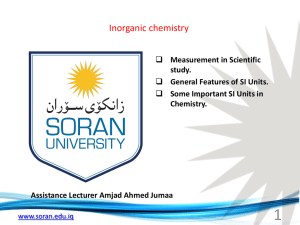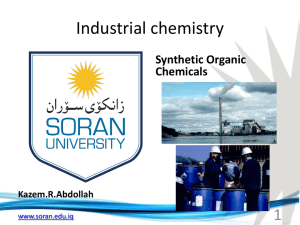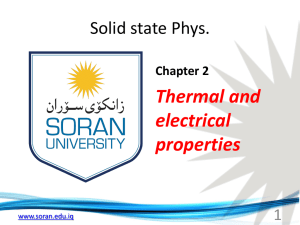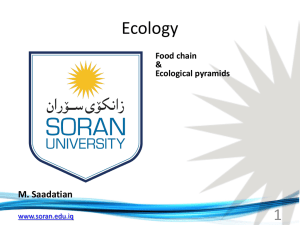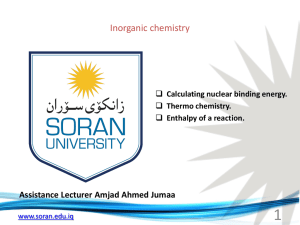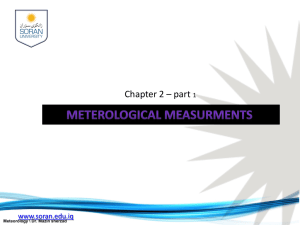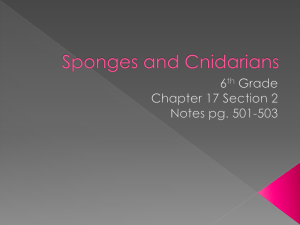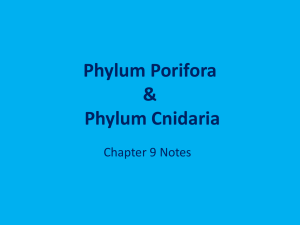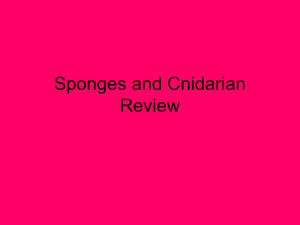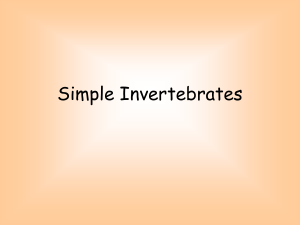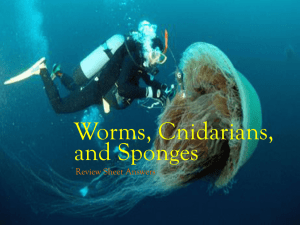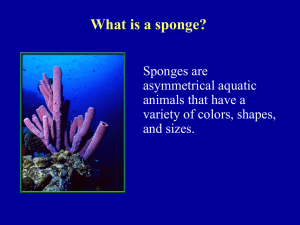2-Vertebratesandinvertebrates(1)
advertisement
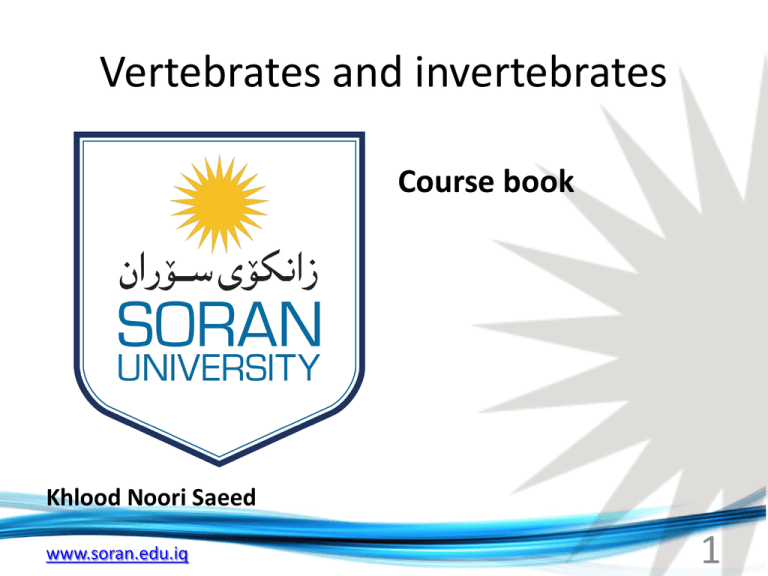
Vertebrates and invertebrates
Course book
Khlood Noori Saeed
www.soran.edu.iq
1
SUBJECT OUTLINE
2015-2014
www.soran.edu.iq
2
Subject title
Vertebrates and invertebrates
Credit hours 2
)Theory( 2
Units 2
Stage
four stage
Class schedule
120 minute, one sessions per
week
Duration 27 weeks
weeks 20
Course coordinator
Assistant Lecturer
Kazem.asiaban@soran.edu.iq
khlood.saeed@soran.edu.iq
www.soran.edu.iq
3
Description
Teaching students the science of comparative anatomy of vertebrates and invertebrates and the
structures of the organs which fond in different living organisms and know how it developed.
Require Background or Experience .2
Many student know about the human body organs and the functions and their effect.
Subject Objective
.
3
A)Understand the fundamental concepts of comparative anatomy and the scientific vocabulary used in this field.
B) different between vertebrates and invertebrates.
.
:Text book(s) and Readings .4
Kardong vertebrate comperative anatomy
.)2(
3(
4(
:Student Materials .5
Textbook and References .1
Lecture Notes .2
CD and internet resources .3
Collage Facilities .6
Classroom with Whiteboard and projection facilities .1
College library .2
data show
3
www.soran.edu.iq
4
Week 1
The vertebrate body
Comparative anatomy: is the study of structure , of the functional
significance of structure , and of the range of variation in structure and function in
different species.
Its methods are descriptive and experimental .Comparative anatomy has its roots
in philosophy , and its aim is enlightenment.
The benefits of comparative anatomy study:
1-To attempt study history of different species and the environmental condition
under which they rose , flourished , and become extinct.
2-To help satisfy the curiosity of human mind.
Vertebrate characteristics [the big four]:
Have four definitive structural characteristics:
1-The presence of notochord , at least in the embryo.
2-The presence of a pharynx with pouches or slits in its wall , at least in the
embryo.
3-The occurrence of a dorsal , tubular nervous system.
4-The presence of vertebral column
www.soran.edu.iq
.
5
Week 2
Notochord and vertebral column
Notochord: Is the first skeletal structure to appear in vertebrate
embryo.
It is a rod of living cells.
*Notochord location:
Located immediately ventral to the central nervous system and
dorsal to the alimentary canal.
*Notochord extending from:
Extending from the midbrain to the tip of the tail
*Notochord origin:
From die roof of the archenteron, or embryonic gut
www.soran.edu.iq
.
6
Week 3
Pharynx:
The pharynx is the region of the alimentary canal exhibiting
pharyngeal pouches in the embryo.
The pouches may rupture to the exterior form pharyngeal slits .
These slits may remain throughout life , or they may be
temporary .
If the slits remain throughout life , the adult pharynx is the part
of the alimentary canal having slits.
If the slits is temporary , the adult pharynx is part of the
alimentary canal connecting the oral cavity and esophagus.
www.soran.edu.iq
7
Week 4
Satellite characteristics:
*Skin: [the integument]
Skin of vertebrates consist of :
1-epidermis of ectoderm origin .
2-underlying dermis of
mesodermal origin.
www.soran.edu.iq
8
Week 5
Metamerism:
Serial repetition of body structure in the longitudinal axis is known as
metamerism.
-The successive body segments of earthworms are readily seen externally as well as
internally .
-In crayfish the metamerism is obvious in the caudal region , but in the trunk it is
obscured dorsally by the carapace.
-In vertebrate metamerism clearly expressed in embryos and is retained in many
adult system .
No external evidence is seen in vertebrate ???
Because the skin is not metameric .
-But if the integument is stripped from the body of fishes , amphibians , and even
some reptiles , a series of identical muscle segments is seen .
-The serial arrangement of body wall muscles , vertebrae , ribs , spinal nerves ,
embryonic kidney tubules , segmental arteries and veins is an expression of the
.
fundamental metamerism of vertebrates
www.soran.edu.iq
9
Week 6
Digestive organs:
The digestive ( alimentary ) tract exhibits specialized regions for the:
1-acquisition
2-processing 3-temporary storage 4-digestion
5-absorption of food
6-elimination of the unabsorbed residue.
Digestive tract consist of :
1-oral cavity
2-pharynx
3-esophagus
4-stomach
5-intestine ( coiled to increase absorptive area without increasing the body
length )
6-anus or vent
-The tract exhibits a number of ceca or diverticula , including a liver and
pancreas
.
www.soran.edu.iq
10
Week 7
Urinogenital organs:
Urinary and reproductive systems share
certain passageways , because urinary and
reproductive organs of vertebrate are closely
related , kidneys and gonads arise close
together in the roof of the coelom.
www.soran.edu.iq
11
Week 8
Invertebrates
Animals species that do not develop a vertebral column include
many animals like insects – worms – clams – crabs – octopus – and
other……
The largest animal Phylum or Superphylum is also included within
invertebrates :
1- Protozoa
2- Porifera
3- cnidaria { coelentrata }
4- Aschelminthes
5- Mollusca
6- Annelida
7- Echinodermata
8- Arthropoda
www.soran.edu.iq
12
Week 9
Protozoa
General Characters:
1-Unicellular ( or colonial ) and microscopic animals .
2-Most are motile by flagella , cilia or pseudopodia .
3-Most protozoal species are aerobic , but some anaerobic species have
been found in the human intestine and animal rumen.
4-They occur in all habitats including marine , freshwater ,and terrestrial ,
including soil.
5-The food inter to the cell ( body of animal ) by mouth of cell or by body
wall but the digestive happen in food vacuole in cytoplasm.
6-Osmoregulation in freshwater protozoans is accomplished by contractile
vacuoles that pump a hyposomatic urine from the cytoplasm back into the
environment.
7-Most protozoa reproduce by asexual methods ( binary fission , budding ,
multiple fission , plasmotomy ) , or sexual reproduction ( syngamy ,
conjugation ) .
8-Some
species are parasites of plants and human .
www.soran.edu.iq
13
Week 10
Cytoplasm
1-Protoplasm part located outside nuclei.
2-Homogenous , contain many of vacuoles.
3-Reticullar , not colour .
4-Divided into :
a-Ectoplasm ( near the cell membrane )
b-Endoplasm ( near the nuclei membrane )
-Ectoplasm : is a gel containing the basal bodies of cilia or
flagella , microfilaments .
-Endoplasm : or ( sol ) more fluid than ectoplasm and contain
organelles such as nuclei , mitochondria and vacuoles and
vesicles of various types.
www.soran.edu.iq
14
Week 11
Locomotor Organelles
1-Flagella
2-Cilia
3-Pseudopodia
Cilia
1-are short hair like appendages
Extending from the surface of
Living cells.
2-Rotational, like a motor very
Fast moving.
compared to cilia.
3-Many ( hundreds )per cell
4-Eukaryotic cells
cells
www.soran.edu.iq
Flagella
1-are long thread like appendages
on the surface of living cell.
2-Wave –like ,undulating ,
Sinusoidal , slow movement
3-Few ( less than 10 )per cell
4-Eukaryotic and Prokaryotic
15
Week 12
Euglena
1-Biflagellated , unicell , spindle shape .
2-Most species have photosynthesizing , chloroplast within the body of cell. Chloroplasts
contain pyrenoid used in the synthesis of paramylon , a form of starch energy storage.
3-Have two flagella rooted in basal bodies located in a small reservoir of the front of the cell ,
one of flagellum is very short while the other is long easily visible with light microscopy.
4-Possess red eyespot ( stigma ) , an organelle composed of carotenoid pigment granules . The
red spot itself is not thought to be photosynthetic so that paraflagellar body it filters the sun
light located at the base of flagellum.
5-Lake a cell wall instead it has pellicle made of protein layer supported by structure of
microtubules arranged in strips spiraling around the cell , pellicle give exceptional flexibility and
contractility , there is no cellulose.
6-Euglenoids are found in many freshwater habitats , and are most abundant in those .
7-Small and inconspicuous contractile vacuole is located to one side of the reservoir into which
it discharges , it function is osmoregulatory.
8-Repreduce a sexually through binary fission a form of cell division , divide longitudinally
beginning at the front end of the cell with the duplication of flagellar processes , and stigma .A
cleavage forms in the anterior and V-shaped moves toward the posterior , until the two halves
are entirely separated , sexual conjugation are rare.
www.soran.edu.iq
16
Week 13
Amoeba
1-They so tiny need microscope to see them .
2-Living in water , including lakes , ponds , streams , rivers , and puddles .Some can
live in the bodies of animals.
3-Move by pseudopodia and help Amoeba to eat .
4-Reproduce by binary fission , it means that one Amoeba can split in half and make
two identical new Amoeba.
5-Cytoplasm divided into two parts:
a-endoplasm
b-ectoplasm …….both enclosed within a flexible plasma membrane.
6-Cell contain single granular nucleus containing DNA.
7-Contractile vacuole is used to maintain osmotic equilibrium by excreting excess
water from the cell.
8-An Amoeba obtain its food by phagocytosis , and particles of organic matter , or by
pinocytosis taking in dissolved nutrient through vesicles formed within the cell
membrane.
www.soran.edu.iq
17
Week 14
Phylum : Porifera ( Sponges )
Sponges are animals of the phylum porifera ( meaning : pore bearer ). Sponges are a diverse group
of sometimes common types with about 5000 species known across the world . Sponges are
primarily marine , but around 150 species live in freshwater.
General characters
1-Include a system of pores ( also called ostia ) and canals , through which water passes .
2-Sponges are either radially symmetrical or a symmetrical .
3-They are supported by a skeleton made up of the protein collagen and spicules , which may be
calcareous or siliceous , depending on the group of sponges examined.
4-They are multicellular organisms and have an specialized cells that can transform into other types
and which often migrate between the main cell layers and mysophyl in the process.
5-Sponges do not have nervous , digestive or circulatory systems , instead most rely on maintaining
a constant water flow through their bodies to obtain food and O2 and remove wastes.
6-All sponges are sessile aquatic animals.
7-Many species feed on bacteria and other food particles in the water, some host photosynthesizing
microorganism . A few species of sponges that live in food –poor environment have become
carnivores that may prey mainly on small crustacea .
8-Most species reproduce by sexual reproduction and other by a sexual reproduction.
www.soran.edu.iq
18
Week 15
Sponge Types :
Sponges have three different types of body plans:1-Asconoid : Sponges are shaped like a simple tube perforated by pores. The
open internal part of the tube is called the spongocoel , it opening to the
outside , the osculum.
2-Syconoid : Sponges tend to be larger the asconoids , have a tubular body
with a single osculum . The syconoid body wall is thicker and the pores that
penetrate it are longer , forming a system of simple canals . These canals are
lined by collar cells , the flagella of which move water from the outside , into
the spongocoel and out the osculum.
3-Leuconoid : These are largest and most complex sponges. These sponges
are made up of masses of tissue . Penetrated by numerous canals . Canals
lead to numerous small chambers lined with flagellated cells . Water move
through the canals , into these chambers , and out via a central canal and
osculum.
www.soran.edu.iq
19
Week 16
Phylum : Cnidaria = Coelenterata
General characteristics :
1-Radial symmetry .
2-Diploblast ( two germ layers during development ectoderm and endoderm ).
3-Adult body with an outer cellular layer ( epidermis or ectodermis )and an inner
cellular layer ( gastrodermis ) with anon cellular – layer ( Mesoglea =jelly – like
material ) in between .
4-Some specialized tissue present .
5-Posses unique stinging or adhesive structures ( cnidae ) found in specialized cells
(cnidocytes ) most common cnidae called Nematocysts
[ that fire like harpoons and used mainly to capture prey also as anchors in some
species ].
6-Simple nerve net forms a nervous system .
7-Alternation of generation with a sexual reproducing polyp stage and sexual
reproducing medusa stage variation of this strategy exist throughout the cnidaria .
8-Have a ciliated , motile planula larvae .
www.soran.edu.iq
20
week 17
Hydra
Phylum : Cnidaria
Class : Hydrozoa
Order : Anthomedusae
Family : Hydridae
Genus : Hydra
General characteristic of Hydra :
1-Small , multicellular , has tubular body up to 10 mm.
2-Radial symmetry.
3-They can found in most un polluted freshwater , ponds , lakes and streams in the temperature
and tropical regions.
4-Contain in the foot region basal disc , gland cells in the basal disc secrete a sticky fluid that
accounts for its adhesive properties.
5-Mouth found in free end of the body surrounded by ( 1-12 ) thin mobile tentacles , each
tentacle or cnida ( plural cnidae ) clothed with highly specialized stinging cells ( cnidocytes )
contain specialized structures called ( Nematocysts ).
6-The nervous system of hydra is a nerve net , which is structurally simple compared to
mammalian nervous system , and there are sensitive nerve cells , located in the body wall and
tentacles.
7-Reproduction and Excretion occur by diffusion everywhere through the epidermis.
8-Hydra undergoes morphallaxis ( tissue regeneration ) when injured or severed.
www.soran.edu.iq
21
Week 18
Types of cells in Hydra :
*Epidermis layers :1-Epithelio-muscular cells .
2-Sensory cells.
3-Nerve cells.
4-Interstitial cells.
5-Cnidocytes.
6-Germ cells.
*Endodermis layers :1-Epithelio-muscular cells ( digestive cells ).
2-Interstitial cells.
3-Sensory cells.
4-Nerve cells.
5-Gland cells.
www.soran.edu.iq
22
Week 19
Cnidocyte:
A cnidocyte ( also known as a cnidoblast or nematocyte ) is an
explosive cell containing one giant secretory organelle or
cnida (plural cnidae ) that defines the phylum : Cnidaria (
corals , sea anemones , hydrae , jelly fish , etc…) .
Cnidae are used for prey capture and defense from predators
. despite being morphologically simple , lacking a skeleton
and usually being sessile , cnidarians prey on fish and
crustaceans . A cnidocyte fires a structure that contains the
toxin , from a characteristics subcellular organelle called a
cnidocyst ( also known as a cnida or nematocyst ) . This is
responsible for the sting delivered by a cnidarians
www.soran.edu.iq
.
23
Week 20
Structure and function:
Each cnidocyte cell contains an organelle called a cnida or cnidocyst
( e.g. nematocyst ) , which comprises a bulb –shape capsule
containing a coild hollow tubule structure attached to it . The
immature cnidocyte is referred to as a cnidoblast . The externally
oriented side of the cell also has a hair –like trigger called a
conidocil .When the trigger is activated , the tubule shaft of the
cnidocyst is ejected and in the case of the penetrant nematocyst ,
the forcefully ejected tubule penetrate the target organism. This
discharge takes no more than a few microseconds , and is able to
reach accelerations of about 40,000 g .Recent research suggests the
process to occur as fast as 700 nanoseconds , thus reaching an
acceleration of up to 5,410,000 g .After penetration , the toxic
content of the nematocyst is injected into the target organism ,
allowing the sessile cnidarians to devour it
www.soran.edu.iq
.
24
